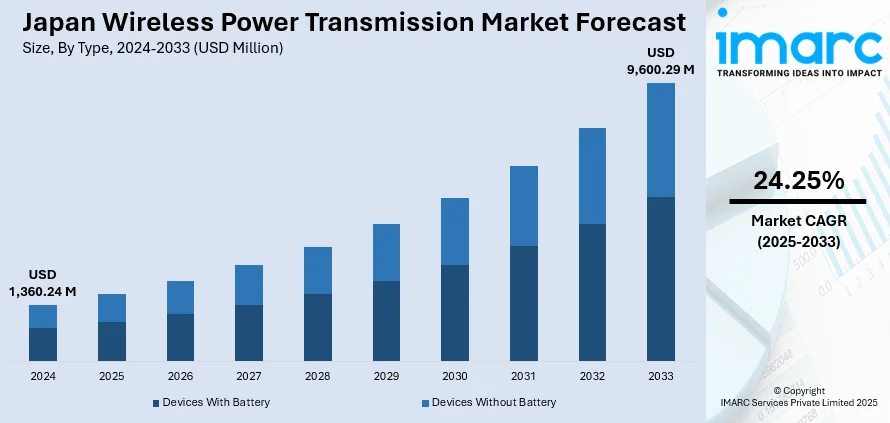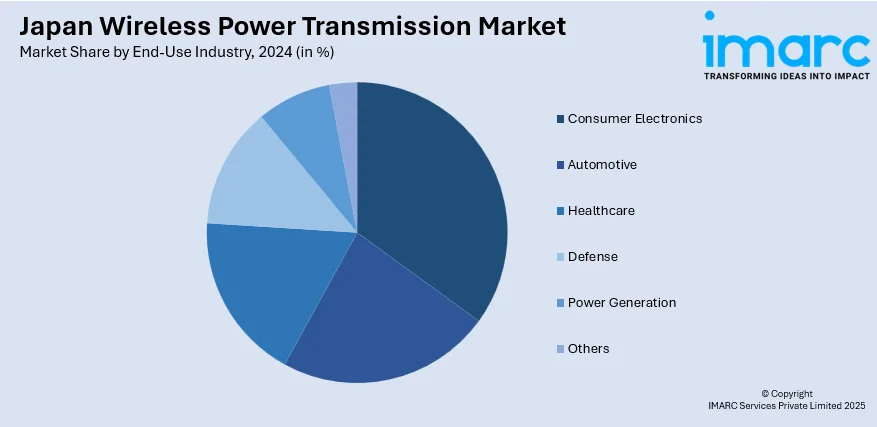
Japan Wireless Power Transmission Market Size, Share, Trends and Forecast by Type, Technology, Implementation, Receiver Application, End-Use Industry, and Region, 2025-2033
Japan Wireless Power Transmission Market Overview:
The Japan wireless power transmission market size reached USD 1,360.24 Million in 2024. Looking forward, IMARC Group expects the market to reach USD 9,600.29 Million by 2033, exhibiting a growth rate (CAGR) of 24.25% during 2025-2033. Robust research and development (R&D) activities, government support, rising electric vehicle (EV) adoption, escalating smart home expansion, growing factory automation, increasing demand for healthcare devices, innovation in consumer electronics, and the development of public infrastructure pilot programs are some of the factors supporting the market growth.
|
Report Attribute
|
Key Statistics
|
|---|---|
|
Base Year
|
2024 |
|
Forecast Years
|
2025-2033
|
|
Historical Years
|
2019-2024
|
| Market Size in 2024 | USD 1,360.24 Million |
| Market Forecast in 2033 | USD 9,600.29 Million |
| Market Growth Rate 2025-2033 | 24.25% |
Japan Wireless Power Transmission Market Trends:
R&D Investments and Technological Advancements
The sustained focus on research and development (R&D) has a significant impact on the Japan wireless power transmission market growth. The Japanese companies and universities are working together to introduce wireless power transfer systems, such as magnetic resonance, inductive coupling, and microwave systems. For instance, in 2023, the University of Tokyo, Chiba University and nine companies, including Bridgestone Mitsui Fudosan, ROHM, and NSK, among others, started the first in-motion wireless charging systems for EVs trial on a public road in Kashiwa-no-ha Smart City, Chiba Prefecture. The government-backed project, which will continue until March 2025, uses precast power transmission coils that are embedded into the surface of some roads around traffic lights. In addition, ongoing R&D has produced advances in transmission efficiency, range, and multi-device support, all of which are critical to mass-market adoption. In line with this, key market players, such as Panasonic, Toshiba and Murata Manufacturing, are heavily investing into consumer and industrial applications, which is providing an impetus to the market growth.

Government Support and Regulatory Backing
Government support is one of the primary factors shaping a positive environment for the Japan wireless power transmission market outlook. The government organizations, such as Ministry of Economy, Trade and Industry (METI) and the New Energy and Industrial Technology Development Organization (NEDO), are actively working to develop next-generation energy and charging infrastructure and are pushing wireless power innovation via policy incentives and demonstration projects. These projects aim to reduce dependence on wired infrastructure and enable energy-efficient offerings in the context of Japan's overall smart city and carbon neutrality goals. Moreover, regulatory frameworks are streamlined to allow experimentation in public spaces, such as wireless EV charging roads and urban mobility nodes, which is boosting the market growth. The incorporation of wireless infrastructure into public infrastructure also receives support through zoning adjustments and safety standards are fostering the market growth.
Expansion of Robotics and Factory Automation
Japan's leadership in robotics and industrial automation has created a strong use case for wireless power transmission. In high-precision and safety-critical environments such as semiconductor fabrication and automotive manufacturing, eliminating power cables helps reduce hazards, enhance operational efficiency, and enable greater flexibility in machine layout. Autonomous mobile robots (AMRs), automated guided vehicles (AGVs), and collaborative robots are increasingly being equipped with wireless charging pads, allowing them to operate with minimal downtime. The shift toward Industry 4.0 and smart manufacturing has further accelerated interest in contactless energy systems that support continuous operations and predictive maintenance. Apart from this, Japanese manufacturers are piloting inductive and resonant charging solutions that can operate in dust-prone or hazardous conditions where traditional connections are less reliable, which is further boosting the Japan wireless power transmission market share.
Japan Wireless Power Transmission Market Segmentation:
IMARC Group provides an analysis of the key trends in each segment of the market, along with forecasts at the region level for 2025-2033. Our report has categorized the market based on type, technology, implementation, receiver application, and end-use industry.
Type Insights:
- Devices With Battery
- Devices Without Battery
The report has provided a detailed breakup and analysis of the market based on the type. This includes devices with battery and devices without battery.
Technology Insights:
- Near-Field Technology
- Inductive
- Magnetic Resonance
- Capacitive Coupling/Conductive
- Far-Field Technology
- Microwave/RF
- Laser/Infrared
A detailed breakup and analysis of the market based on the technology have also been provided in the report. This includes near-field technology (inductive, magnetic resonance, and capacitive coupling/conductive) and far-field technology (microwave/rf and laser/infrared).
Implementation Insights:
- Aftermarket
- Integrated
The report has provided a detailed breakup and analysis of the market based on the implementation. This includes aftermarket and integrated.
Receiver Application Insights:
- Smartphones
- Tablets
- Wearable Electronics
- Notebooks
- Electric Vehicles
- Robots
- Others
A detailed breakup and analysis of the market based on the receiver application have also been provided in the report. This includes smartphones, tablets, wearable electronics, notebooks, electric vehicles, robots, and others.
End-Use Industry Insights:

- Consumer Electronics
- Automotive
- Healthcare
- Defense
- Power Generation
- Others
The report has provided a detailed breakup and analysis of the market based on the end-use industry. This includes consumer electronics, automotive, healthcare, defense, power generation, and others.
Regional Insights:
- Kanto Region
- Kansai/Kinki Region
- Central/Chubu Region
- Kyushu-Okinawa Region
- Tohoku Region
- Chugoku Region
- Hokkaido Region
- Shikoku Region
The report has also provided a comprehensive analysis of all the major regional markets, which include Kanto Region, Kansai/Kinki Region, Central/Chubu Region, Kyushu-Okinawa Region, Tohoku Region, Chugoku Region, Hokkaido Region, and Shikoku Region.
Competitive Landscape:
The market research report has also provided a comprehensive analysis of the competitive landscape. Competitive analysis such as market structure, key player positioning, top winning strategies, competitive dashboard, and company evaluation quadrant has been covered in the report. Also, detailed profiles of all major companies have been provided.
Japan Wireless Power Transmission Market News:
- In 2024, Sinanen Holdings entered into a partnership with WiTricity to expand the sales of WiTricity's wireless charging products in the Japanese market, aiming to promote the adoption of wireless EV charging solutions.
- In 2024, WiTricity Corporation, a U.S.-based pioneer in electric vehicle (EV) wireless power transfer technology, established its Japanese subsidiary, WiTricity Japan K.K., in Tokyo. This strategic move aims to promote wireless power transfer projects in Japan and marks WiTricity's commitment to advancing EV wireless charging infrastructure in the region.
Japan Wireless Power Transmission Market Report Coverage:
| Report Features | Details |
|---|---|
| Base Year of the Analysis | 2024 |
| Historical Period | 2019-2024 |
| Forecast Period | 2025-2033 |
| Units | USD Million |
| Scope of the Report |
Exploration of Historical Trends and Market Outlook, Industry Catalysts and Challenges, Segment-Wise Historical and Future Market Assessment:
|
| Types Covered | Devices With Battery, Devices Without Battery |
| Technologies Covered |
|
| Implementations Covered | Aftermarket, Integrated |
| Receiver Applications Covered | Smartphones, Tablets, Wearable Electronics, Notebooks, Electric Vehicles, Robots, Others |
| End-Use Industries Covered | Consumer Electronics, Automotive, Healthcare, Defense, Power Generation, Others |
| Regions Covered | Kanto Region, Kansai/Kinki Region, Central/ Chubu Region, Kyushu-Okinawa Region, Tohoku Region, Chugoku Region, Hokkaido Region, Shikoku Region |
| Customization Scope | 10% Free Customization |
| Post-Sale Analyst Support | 10-12 Weeks |
| Delivery Format | PDF and Excel through Email (We can also provide the editable version of the report in PPT/Word format on special request) |
Key Questions Answered in This Report:
- How has the Japan wireless power transmission market performed so far and how will it perform in the coming years?
- What is the breakup of the Japan wireless power transmission market on the basis of type?
- What is the breakup of the Japan wireless power transmission market on the basis of technology?
- What is the breakup of the Japan wireless power transmission market on the basis of implementation?
- What is the breakup of the Japan wireless power transmission market on the basis of receiver application?
- What is the breakup of the Japan wireless power transmission market on the basis of end-use industry?
- What is the breakup of the Japan wireless power transmission market on the basis of region?
- What are the various stages in the value chain of the Japan wireless power transmission market?
- What are the key driving factors and challenges in the Japan wireless power transmission?
- What is the structure of the Japan wireless power transmission market and who are the key players?
- What is the degree of competition in the Japan wireless power transmission market?
Key Benefits for Stakeholders:
- IMARC’s industry report offers a comprehensive quantitative analysis of various market segments, historical and current market trends, market forecasts, and dynamics of the Japan wireless power transmission market from 2019-2033.
- The research report provides the latest information on the market drivers, challenges, and opportunities in the Japan wireless power transmission market.
- Porter's five forces analysis assist stakeholders in assessing the impact of new entrants, competitive rivalry, supplier power, buyer power, and the threat of substitution. It helps stakeholders to analyze the level of competition within the Japan wireless power transmission industry and its attractiveness.
- Competitive landscape allows stakeholders to understand their competitive environment and provides an insight into the current positions of key players in the market.
Need more help?
- Speak to our experienced analysts for insights on the current market scenarios.
- Include additional segments and countries to customize the report as per your requirement.
- Gain an unparalleled competitive advantage in your domain by understanding how to utilize the report and positively impacting your operations and revenue.
- For further assistance, please connect with our analysts.
 Request Customization
Request Customization
 Speak to an Analyst
Speak to an Analyst
 Request Brochure
Request Brochure
 Inquire Before Buying
Inquire Before Buying




.webp)




.webp)












